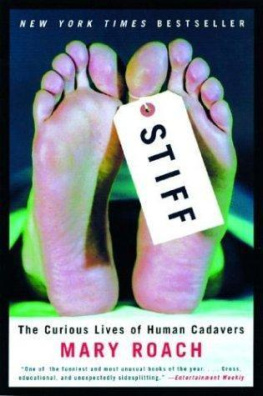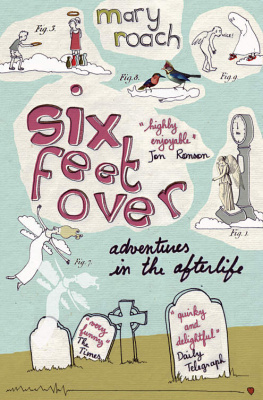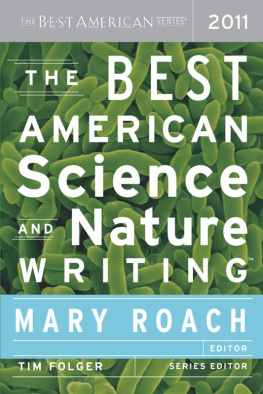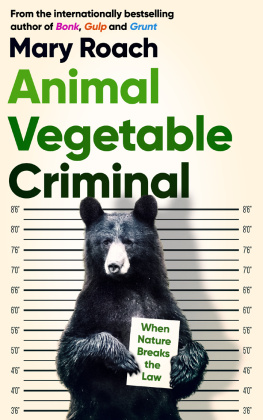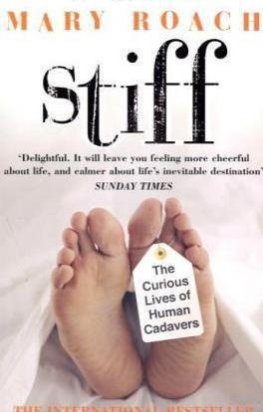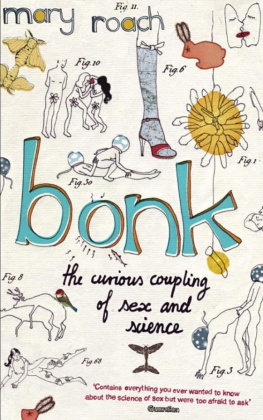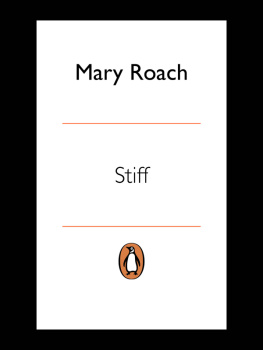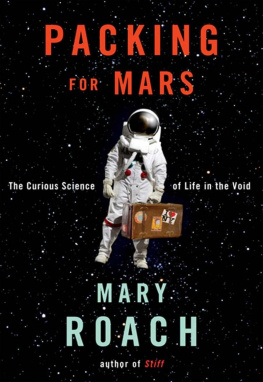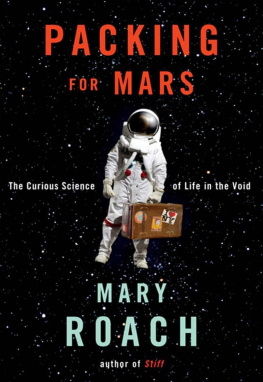

STIFF
The Curious Lives of Human Cadavers
Mary Roach
VIKING
an imprint of PENGUIN BOOKS
VIKING
Published by the Penguin Group
Penguin Books Ltd, 80 Strand, London WC2R ORL, England
Penguin Putnam Inc., 375 Hudson Street, New York, New York 10014, USA
Penguin Books Australia Ltd, 250 Camberwell Road, Camberwell, Victoria 3124, Australia
Penguin Books Canada Ltd, 10 Alcorn Avenue,Toronto, Ontario, Canada M4V 3B2
Penguin Books India (P) Ltd, 11 Community Centre, Panchsheel Park, New Delhi - 110 017, India
Penguin Books (NZ) Ltd, Cnr Rosedale and Airborne Roads, Albany, Auckland, New Zealand
Penguin Books (South Africa) (Pty) Ltd, 24 Sturdee Avenue, Rosebank 2196, South Africa
Penguin Books Ltd, Registered Offices: 80 Strand, London WC2R ORL, England
www.penguin.com
First published in the United States of America by W.W. Norton & Company Ltd. 2003
First published in Great Britain by Viking 2003
Copyright Mary Roach, 2003
The moral right of the author has been asserted
In several instances, names have been changed to respect privacy Photo credits: title page: Hulton Deutsch Collection/Corbis; p.17: Getty Images/Juliette Lasserre; p.35: Getty Images/Robin Lynn Gibson; p.59: Photofest; p.85: Photofest; p.111: Getty Images/Stephen Swintek; p.129: Hulton Deutsch Collection/Corbis; p.155: Geoffrey Clements/Corbis; p.
165: Getty Images/Tracy Montana/Photolink; p. 197: Bettmann/Corbis; p.219: Getty Images/John A. Rizzo; p.249: Minnesota Historical Society/Corbis; p.279:T.R.Tharp/Corbis
All rights reserved.
Without limiting the rights under copyright reserved above, no part of this publication may be reproduced, stored in or introduced into a retrieval system, or transmitted, in any form or by any means (electronic, mechanical, photocopying, recording or otherwise), without the prior written permission of both the copyright owner and the above publisher of this book
Printed in Great Britain by Clays Ltd, St Ives plc
A CIP catalogue record for this book is available from the British Library ISBN 0-670-91217-4
Whether buried, burnt, snatched, dissected or decomposed, some people have been more useful dead than alive. From testing the efficiency of the guillotine, experiments to determine the weight of the soul, and calibrating crash-test dummies, to advances in modern medicine, the deceased body has been a silent partner to many of the major advances in the understanding of ourselves.
In this fascinating, unusual exploration into the macabre, Mary Roach's search for the many uses of the human body stretches from China and the myth of human dumplings, the ghoulish history of nineteenth-century body-snatching and experiments involving crucifixion to check the veracity of the Turin Shroud, to a present-day Body Farm, plastic-surgery labs and conferences on human composting.
Stiff tells a story of the last 2,000 years, in which cadavers have been at the forefront of scientific exploration: from Ancient Egypt to medieval pharmacies and even the contemporary labs that have successfully performed a head transplant on a monkey. Combining riveting story-telling with science, history and reportage, Stiff is one of the funniest, most intriguing books you will ever read.
For wonderful Ed
Contents
Practicing surgery on the dead
Body snatching and other sordid tales from the dawn of human dissection 3.
On human decay and what can be done about it
Human crash test dummies and the ghastly, necessary science of impact tolerance
When the bodies of the passengers must tell the story of a crash 6.
The sticky ethics of bullets and bombs
The crucifixion experiments
Beating-heart cadavers, live burial, and the scientific search for the soul 9.
Decapitation, reanimation, and the human head transplant 10.
Medicinal cannibalism and the case of the human dumplings 11.
And other new ways to end up
Will she or won't she?
Introduction
The way I see it, being dead is not terribly far off from being on a cruise ship. Most of your time is spent lying on your back. The brain has shut down. The flesh begins to soften. Nothing much new happens, and nothing is expected of you.
If I were to take a cruise, I would prefer that it be one of those research cruises, where the passengers, while still spending much of the day lying on their backs with blank minds, also get to help out with a scientist's research project. These cruises take their passengers to unknown, unimagined places. They give them the chance to do things they would not otherwise get to do.
I guess I feel the same way about being a corpse. Why lie around on your back when you can do something interesting and new, something useful ?
For every surgical procedure developed, from heart transplants to gender reassignment surgery, cadavers have been there alongside the surgeons, making history in their own quiet, sundered way. For two thousand years, cadaverssome willingly, some unwittinglyhave been involved in science's boldest strides and weirdest undertakings. Cadavers were around to help test France's first guillotine, the "humane" alternative to hanging. They were there at the labs of Lenin's embalmers, helping test the latest techniques. They've been there (on paper) at Congressional hearings, helping make the case for mandatory seat belts. They've ridden the Space Shuttle (okay, pieces of them), helped a graduate student in Tennessee debunk spontaneous human combustion, been crucified in a Parisian laboratory to test the authenticity of the Shroud of Turin.
In exchange for their experiences, these cadavers agree to a sizable amount of gore. They are dismembered, cut open, rearranged. But here's the thing: They don't endure anything. Cadavers are our superheros: They brave fire without flinching, withstand falls from tall buildings and head-on car crashes into walls. You can fire a gun at them or run a speedboat over their legs, and it will not faze them. Their heads can be removed with no deleterious effect. They can be in six places at once. I take the Superman point of view: What a shame to waste these powers, to not use them for the betterment of humankind.
This is a book about notable achievements made while dead. There are people long forgotten for their contributions while alive, but immortalized in the pages of books and journals. On my wall is a calendar from the Mtter Museum at the College of Physicians of Philadelphia. The photograph for October is of a piece of human skin, marked up with arrows and tears; it was used by surgeons to figure out whether an incision would be less likely to tear if it ran lengthwise or crosswise. To me, ending up an exhibit in the Mtter Museum or a skeleton in a medical school classroom is like donating money for a park bench after you're gone: a nice thing to do, a little hit of immortality. This is a book about the sometimes odd, often shocking, always compelling things cadavers have done.
Not that there's anything wrong with just lying around on your back. In its way, rotting is interesting too, as we will see. It's just that there are other ways to spend your time as a cadaver. Get involved with science.
Be an art exhibit. Become part of a tree. Some options for you to think about.
Death. It doesn't have to be boring.
There are those who will disagree with me, who feel that to do anything other than bury or cremate the dead is disrespectful. That includes, I suspect, writing about them. Many people will find this book disrespectful. There is nothing amusing about being dead, they will say.
Next page
